ASUS K53E: Testing Dual-Core Sandy Bridge
by Jarred Walton on April 8, 2011 1:00 AM EST- Posted in
- Laptops
- Intel
- Sandy Bridge
- Asus
The LCD: A Poor Showing Even Among Budget Panels
Once again, we have the usual caveat: the LCD. Even when we’re looking at budget laptops with low-end LCDs, this panel doesn’t impress. The contrast isn’t the worst we’ve seen, but color quality is right near the bottom. I also noticed a dithering pattern when viewing movies and images, more so than with other laptops. I never saw the Gateway ID49C in person, but I’d wager the AUO B156XW02 v6 panel used here gives it a run for the money in terms of being the least desirable LCD. As usual, you get what you pay for, and in this instance you’re paying for a laptop with the least expensive LCD ASUS could scrounge up.
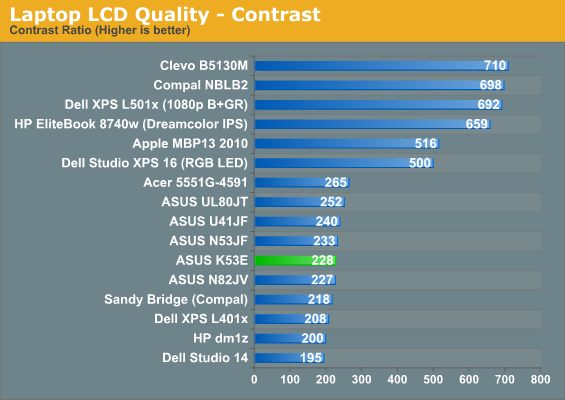
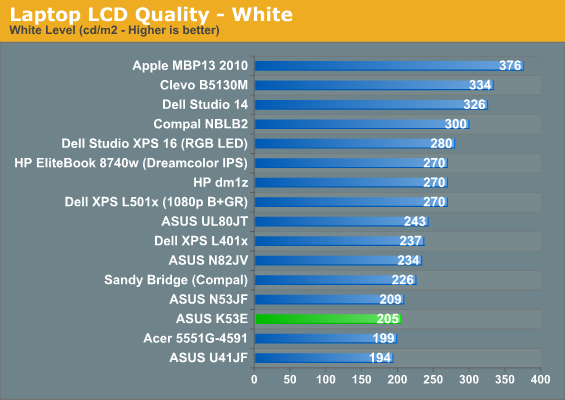

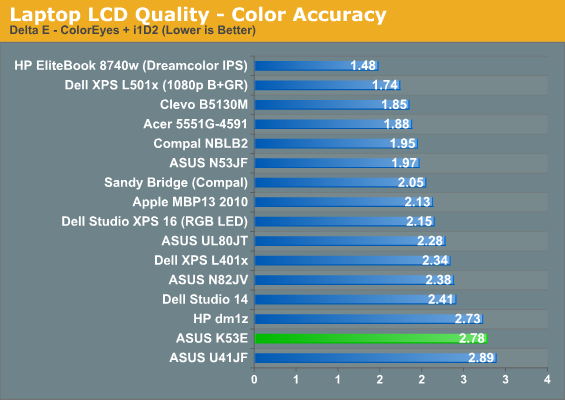
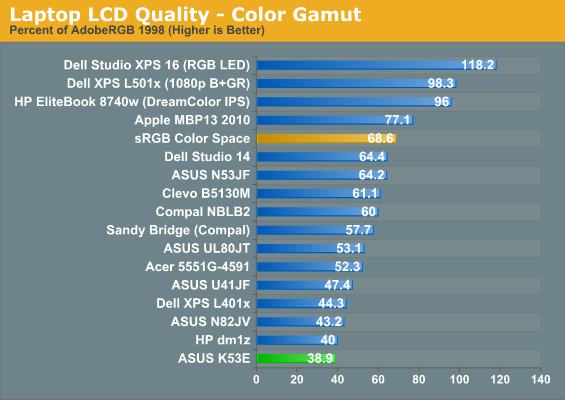
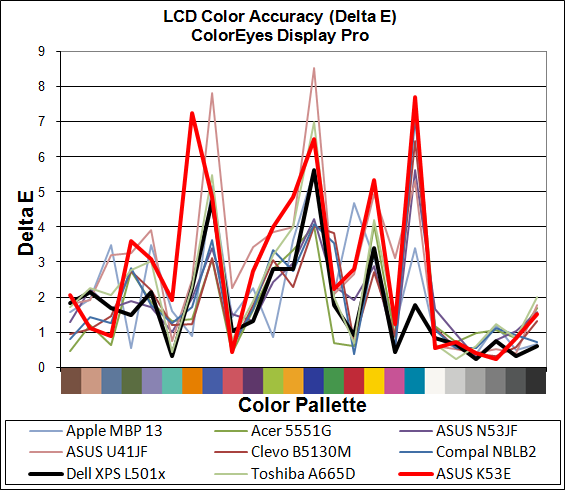

Heat and Noise Levels

For noise and temperature results, we ran through our battery of general application benchmarks (including looping 3DMark06 for several hours). Everything checks out at idle, and load temperatures are within spec. 3DMark06 generates lower CPU temperatures than heavily threaded applications, most likely because the HD 3000 GPU core runs at a higher clock while the CPU runs at stock (or at least not boosted as high). Maximum internal CPU temperatures topped out at 76C, which is lower than we’ve seen with previous laptops, but that might simply be Sandy Bridge vs. Arrandale. External temperatures were also acceptable, but since my digital thermometer is out of commission I don’t have exact figures.
With the reasonable temperatures, noise levels are lower than many competing laptops. At idle, the system is barely above the 30dB noise floor, measuring 30.9dB at a distance of 15 inches. Interestingly, maximum noise levels are a consistent 36.8-37.1dB at load, whether you’re looping 3DMark06 (i.e. playing games), running a 100% CPU load with Cinebench SMP, or doing both. In normal use, though, the laptop remains fairly quiet and wouldn’t cause any dirty looks if used in a business meeting or library.
















78 Comments
View All Comments
JarredWalton - Saturday, April 9, 2011 - link
Brazos C-50 starts at $325, so it's within spitting distance of the Atom N550 (dual-core), and it still has a substantially better IGP -- though it's mostly useful for video as opposed to gaming on the C-50. C-50 is also a lower power and better battery life option, though it may not match the best Atom netbooks. Still, I'm not sure most people need more than 10 hours of battery life, which is what we're talking about at this point.AMD's E-350 is better/faster, but it's also more expensive. I'd be quite surprised if Atom netbooks offered better audio latency. Only thing really missing is a good ASUS equivalent of the 1001P, only with C-50. Right now, the only 10.1" C-50 (or Brazos) netbook comes from Acer, who doesn't have the best reputation. If you're interested, though, the Acer Aspire One 522 is on sale for $300 at Micro Center right now.
krumme - Sunday, April 10, 2011 - link
Have you ever tried an Atom? - if i would say you are a very patient man :)There is absolutely none in my family, with very patient female computer users i tell you, who havnt complained about the speed for basic task like surfing and office use.
In my entire life i have met one person who didnt complain - all other - who thought all computers were the same - have complained. Atom just showed them - who did forget about the old age and windows 95 on 8Mb ram, that computer actually can be different.
What i am pretty comfident about is, that all those user would have been pretty sattisfied with an e350, and stayed in their beliewe there was no difference.
I think it just underlines that Intel and AMD have trouble for the future. The cpu/gpu is just fine as they is now. Then there is just the fight for cost, and it means lower earnings on the traditional markets.
strikeback03 - Monday, April 11, 2011 - link
I was perfectly happy with the one Atom system I have used extensively - the carputer I built in my last car was based around an Atom 330. with 1GB RAM and a 200GB 7200 RPM HDD the only time there was ever any delay running the Centrafuse front-end interface was when a module was first loading after a restart. So for limited uses Atom is fine, so long as the software and experience are designed for that level of performance.krumme - Monday, April 11, 2011 - link
Yeaa, and my atom stream audio fine, and does not feel slow as long as i do not touch it.Atom was not build for anything but tv boxes, competing with arm. And therefore it does not work when anandtech, promotes sb at the expense of bobcat, because it indirectly leads the consumers to tv box computer power. And that is the unintended effect of theese articles.
JarredWalton - Monday, April 11, 2011 - link
So Atom running a custom OS will be much better, obviously. Heck, even Atom chips (by PC standards) are going to be twice as fast as the best smartphone chips -- not on the GPU side, though, but that's a different story. But if you were to go out and buy a laptop for use as a Windows PC, there's still a big gap between $400 laptops and $700 laptops -- more than a 2X increase in performance for less than double the price.My experience is that given the choice (i.e. money not a consideration), no one would want less performance from their laptop. SNB dual-core should be good enough to fit in 13.3" laptops that weigh around 4 lbs., and priced at around $800 (or less) that's a great portable PC. Bobcat will go into smaller devices and offer slightly better battery life, but it's still slower (too slow) on some tasks -- e.g. video transcoding, Flash browser games, and anything else that's computationally intensive will be much better on SNB. So again, Brazos is basically for those who value price more than most other areas.
On a related note, I'd be shocked if any major business tried to replace current generation Arrandale laptops with Brazos laptops. Heck, they wouldn't even replace Core 2 Duo laptops with Brazos. Businesses want a balanced laptop, generally speaking, and right now Intel gives you more performance with good battery life for a reasonable price. AMD competes on the desktop and laptop with lower prices, but when productivity is money, why would you save $150 only to have your employees waste hours of time over the next year? (Well, they'll waste time regardless, but they'll waste even *more* time waiting for a slow computer.)
Long-term, it will be very interesting to see what happens with Windows 8. Windows 7 can run on Atom, but it's clearly a different experience than Win7 on even something like CULV or Brazos. ARM-based SoCs are sort of Brazos, except they're even slower on the CPU side of the fence (and slower on GPU as well). Win8 will need some major changes relative to Win7 to make it viable on tablet and laptop devices running such SoCs.
krumme - Tuesday, April 12, 2011 - link
IT is not a strategic subject for top management anymore.A few years back, they would spend time talking TCO, cost outsourcing, but today is different.
They just dont want to hear about it, and spend valuable time on it. For good reason.
SAP is running for everyone and his brother, the oursourcing is in place. Who cares if its a Dell or HP machine except in IT.
And the IT director, who ofen is an economis, hardly knows what a CPU is. It matters so little no one cares just a few stop up the chain.
The replacement of computers is just done regulary say every 3 years, and what Dell/HP chooses to put in their computers is their business.
If something is interesting about the computers today its screen, keyboard, battery and foremost quality.
The cost differences for a brazos compared to a sb is so slim, it doesnt matter. But lets say the next brazos 28nm q4?, have nearly double the batterylife and a solid turbo, then i think there is a chance we will se a lot of ultra portable business laptops with them.
Except for 10% of the business users i think we are waiting for the HD not the cpu. Therefore i think we will se more cheap ssd and even more noise and battery friendly cpu/gpu in the next generation - standard roll out - business leasing deals.
But as said, for the professional side its just mostly TCO today, and for the consumer side its just more and more cost, cost, cost. Perhaps they are saving for an IPAD3 ? :)
tomycs2007 - Monday, April 11, 2011 - link
"15.6" WLED Glossy 16:9 768p (1366x768)(AU Optronics B156XW02 v6)"
TegiriNenashi - Monday, April 11, 2011 - link
As long as its display has puny vertical 768 pixels resolution. Please bring back 16:10 aspect ratio!